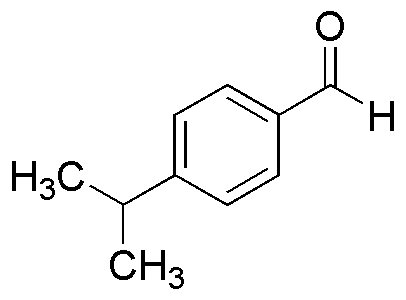Cuminaldehyde is widely utilized in research focused on:
- Flavor and Fragrance Industry: This compound is commonly used as a flavoring agent in food products and as a fragrance component in cosmetics and perfumes, providing a warm, spicy aroma that enhances sensory appeal.
- Pharmaceutical Applications: Cuminaldehyde exhibits antimicrobial properties, making it valuable in the development of natural preservatives and therapeutic agents for various infections.
- Aromatherapy: Its pleasant scent is utilized in essential oils and diffusers, promoting relaxation and well-being, which is increasingly sought after in wellness products.
- Research in Organic Synthesis: This compound serves as a building block in organic chemistry, facilitating the synthesis of more complex molecules, which is crucial for developing new materials and drugs.
- Natural Insect Repellent: Cuminaldehyde has shown efficacy in repelling certain pests, making it a potential ingredient in eco-friendly insect repellent formulations.
General Information
Properties
Safety and Regulations
Applications
Cuminaldehyde is widely utilized in research focused on:
- Flavor and Fragrance Industry: This compound is commonly used as a flavoring agent in food products and as a fragrance component in cosmetics and perfumes, providing a warm, spicy aroma that enhances sensory appeal.
- Pharmaceutical Applications: Cuminaldehyde exhibits antimicrobial properties, making it valuable in the development of natural preservatives and therapeutic agents for various infections.
- Aromatherapy: Its pleasant scent is utilized in essential oils and diffusers, promoting relaxation and well-being, which is increasingly sought after in wellness products.
- Research in Organic Synthesis: This compound serves as a building block in organic chemistry, facilitating the synthesis of more complex molecules, which is crucial for developing new materials and drugs.
- Natural Insect Repellent: Cuminaldehyde has shown efficacy in repelling certain pests, making it a potential ingredient in eco-friendly insect repellent formulations.
Documents
Safety Data Sheets (SDS)
The SDS provides comprehensive safety information on handling, storage, and disposal of the product.
Product Specification (PS)
The PS provides a comprehensive breakdown of the product’s properties, including chemical composition, physical state, purity, and storage requirements. It also details acceptable quality ranges and the product's intended applications.
Certificates of Analysis (COA)
Search for Certificates of Analysis (COA) by entering the products Lot Number. Lot and Batch Numbers can be found on a product’s label following the words ‘Lot’ or ‘Batch’.
*Catalog Number
*Lot Number
Certificates Of Origin (COO)
This COO confirms the country where the product was manufactured, and also details the materials and components used in it and whether it is derived from natural, synthetic, or other specific sources. This certificate may be required for customs, trade, and regulatory compliance.
*Catalog Number
*Lot Number
Safety Data Sheets (SDS)
The SDS provides comprehensive safety information on handling, storage, and disposal of the product.
DownloadProduct Specification (PS)
The PS provides a comprehensive breakdown of the product’s properties, including chemical composition, physical state, purity, and storage requirements. It also details acceptable quality ranges and the product's intended applications.
DownloadCertificates of Analysis (COA)
Search for Certificates of Analysis (COA) by entering the products Lot Number. Lot and Batch Numbers can be found on a product’s label following the words ‘Lot’ or ‘Batch’.
*Catalog Number
*Lot Number
Certificates Of Origin (COO)
This COO confirms the country where the product was manufactured, and also details the materials and components used in it and whether it is derived from natural, synthetic, or other specific sources. This certificate may be required for customs, trade, and regulatory compliance.


